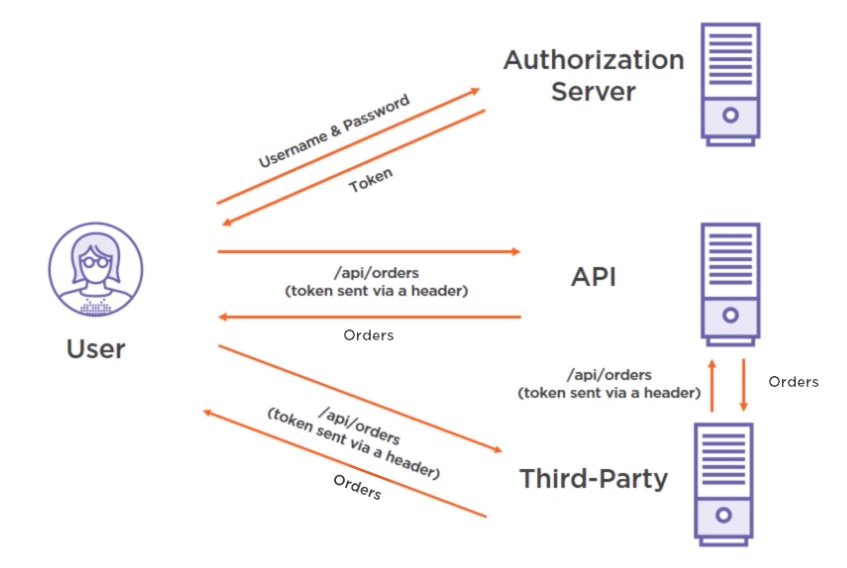Tip: 此篇已加入.NET Core微服务基础系列文章索引
一、IdentityServer的预备知识

要学习IdentityServer,事先得了解一下基于Token的验证体系,这是一个庞大的主题,涉及到Token,OAuth&OpenID,JWT,协议规范等等等等,园子里已经有很多介绍的文章了,个人觉得solenovex的这一篇文章《学习IdentityServer4的预备知识》言简意赅,可以快速的看看。另外savaboard的《ASP.NET Core 之 Identity 入门(一)》和《ASP.NET Core 之 Identity 入门(二)》这两篇也可以一看,对Claims和Identity的基本知识讲的比较通俗易懂,深入浅出,有故事情节,哈哈。

重点关注一下上面这张图(也是来自solenovex的文章),对于一个User(已注册)来说,他会首先向Authorization Server表明自己的身份(比如输入用户名和密码),然后Authorization Server为其发放了一个token,而这个token就好比是把家里的钥匙配了一把(clone)新的,此后该User就可以访问API请求获取Orders(订单)数据了。当然,实际中可能Authorization Server和API Server不在同一个区域内,它们可能只能遥望对方。此外,User还可以基于这个token去访问第三方服务,第三方服务会使用这个API来访问API Server,向其提供token比提供username&password要安全得多。
二、IdentityServer极简介绍
IdentityServer4(这里只使用版本号为4)是一个基于OpenID Connect和OAuth 2.0的针对ASP.NET Core 2.0的框架。IdentityServer是将规范兼容的OpenID Connect和OAuth 2.0终结点添加到任意ASP.NET Core应用程序的中间件。通常,你构建(或重新使用)包含登录和注销页面的应用程序,IdentityServer中间件会向其添加必要的协议头,以便客户端应用程序可以使用这些标准协议与其对话。

我们可以用IdentityServer来做啥?
(1)身份验证服务=>官方认证的OpenID Connect实现
(2)单点登录/注销(SSO)
(3)访问受控的API=>为不同的客户提供访问API的令牌,比如:MVC网站、SPA、Mobile App等
(4)等等等......
三、Started:第一个AuthorizationServer
1.1 建立一个ASP.NET Core空Web项目
建立ASP.NET Core项目,使用Empty空模板。
为了更好地查看日志信息,同时考虑到IISExpress启动起来真的很慢,修改lanuchSettings.json文件如下:
{
"profiles": {
"Manulife.DNC.MSAD.IdentityServer4Test": {
"commandName": "Project",
"launchBrowser": false,
"environmentVariables": {
"ASPNETCORE_ENVIRONMENT": "Development"
},
"applicationUrl": "http://localhost:5000/"
}
}
}
1.2 安装并配置IdentityServer4
Step1.首先安装IdentityServer4:
NuGet>Install-Package IdentityServer4
Step2.配置ASP.NET Core管道,即修改Configure方法
public void Configure(IApplicationBuilder app, IHostingEnvironment env)
{
if (env.IsDevelopment())
{
app.UseDeveloperExceptionPage();
}
app.UseIdentityServer();
}
Step3.为了要把IdentityServer注册到容器中,需要对其进行配置,而这个配置中要包含三个信息:
(1)哪些API可以使用这个AuthorizationServer
(2)哪些Client可以使用这个AuthorizationServer
(3)哪些User可以被这个AuthrizationServer识别并授权
这里为了快速演示,我们写一个基于内存的静态类来快速填充上面这些信息(实际中,可以持久化在数据库中通过EF等ORM获取,也可以通过Redis获取):
public class InMemoryConfiguration
{
public static IConfiguration Configuration { get; set; }
/// <summary>
/// Define which APIs will use this IdentityServer
/// </summary>
/// <returns></returns>
public static IEnumerable<ApiResource> GetApiResources()
{
return new[]
{
new ApiResource("clientservice", "CAS Client Service"),
new ApiResource("productservice", "CAS Product Service"),
new ApiResource("agentservice", "CAS Agent Service")
};
}
/// <summary>
/// Define which Apps will use thie IdentityServer
/// </summary>
/// <returns></returns>
public static IEnumerable<Client> GetClients()
{
return new[]
{
new Client
{
ClientId = "client.api.service",
ClientSecrets = new [] { new Secret("clientsecret".Sha256()) },
AllowedGrantTypes = GrantTypes.ResourceOwnerPasswordAndClientCredentials,
AllowedScopes = new [] { "clientservice" }
},
new Client
{
ClientId = "product.api.service",
ClientSecrets = new [] { new Secret("productsecret".Sha256()) },
AllowedGrantTypes = GrantTypes.ResourceOwnerPasswordAndClientCredentials,
AllowedScopes = new [] { "clientservice", "productservice" }
},
new Client
{
ClientId = "agent.api.service",
ClientSecrets = new [] { new Secret("agentsecret".Sha256()) },
AllowedGrantTypes = GrantTypes.ResourceOwnerPasswordAndClientCredentials,
AllowedScopes = new [] { "agentservice", "clientservice", "productservice" }
}
};
}
/// <summary>
/// Define which uses will use this IdentityServer
/// </summary>
/// <returns></returns>
public static IEnumerable<TestUser> GetUsers()
{
return new[]
{
new TestUser
{
SubjectId = "10001",
Username = "edison@hotmail.com",
Password = "edisonpassword"
},
new TestUser
{
SubjectId = "10002",
Username = "andy@hotmail.com",
Password = "andypassword"
},
new TestUser
{
SubjectId = "10003",
Username = "leo@hotmail.com",
Password = "leopassword"
}
};
}
}
Step4.对于Token签名需要一对公钥和私钥,不过IdentityServer为开发者提供了一个AddDeveloperSigningCredential()方法,它会帮我们搞定这个事,并默认存到硬盘中。当切换到生产环境时,还是得使用正儿八经的证书,更换为使用AddSigningCredential()方法。
public void ConfigureServices(IServiceCollection services)
{
InMemoryConfiguration.Configuration = this.Configuration;
services.AddIdentityServer()
.AddDeveloperSigningCredential()
.AddTestUsers(InMemoryConfiguration.GetUsers().ToList())
.AddInMemoryClients(InMemoryConfiguration.GetClients())
.AddInMemoryApiResources(InMemoryConfiguration.GetApiResources());
}
1.3 获取你心心念念的Token
Step1.启动刚刚我们建立的AuthorizationServer程序,这里我们绑定的是5000端口。
Step2.启动Postman/SoapUI等API测试工具,通过向HTTP Body中填写数据发起POST请求:


Step3.发送一个错误的数据,看看返回的是啥?(这里输入了一个不在定义列表中的client_id)

Step4.查看控制台的日志信息:表示获取Token的这个请求成功了,日志中client_secret和password都是不会直接明文显示的。

Step5.IdentityServer中我们设置这几个API Service的Grant_Type是ResourceOwnerPasswordAndClientCredentials(点击这里了解=>资源拥有者密码凭据许可),因此我们还可以使用ClientCredentials(点击这里了解=>客户端凭据许可),如下所示:

Step6.再次查看控制台日志信息:这次没有关于User相关的任何信息显示了。

Step7.基本的开发结束,对于开发阶段,我们使用IdentityServer为开发者提供的临时证书即可,但是后面仍然需要生成一些正儿八经的证书。这里我们通过OpenSSL来生成,首先去官网下载一个,这里使用的是Win64_1.1版本。打开Powershell或者CMD,输入以下命令:
cmd>openssl req -newkey rsa:2048 -nodes -keyout cas.clientservice.key -x509 -days 365 -out cas.clientservice.cer
下面将生成的证书和Key封装成一个文件,以便IdentityServer可以使用它们去正确地签名tokens
cmd>openssl pkcs12 -export -in cas.clientservice.cer -inkey cas.clientservice.key -out cas.clientservice.pfx
中途会提示让你输入Export Password,这个password后面会用到,记住它。最终导出后的结果如下图所示:

这里我将其放到了项目结构文件夹中,并设置这个pfx文件为“如果较新则复制”,确保可以在最后生成的目录里边。现在就可以修改一下ConfigureServices()方法了:
public void ConfigureServices(IServiceCollection services)
{
var basePath = PlatformServices.Default.Application.ApplicationBasePath;
InMemoryConfiguration.Configuration = this.Configuration;
services.AddIdentityServer()
//.AddDeveloperSigningCredential()
.AddSigningCredential(new X509Certificate2(Path.Combine(basePath,
Configuration["Certificates:CerPath"]),
Configuration["Certificates:Password"]))
.AddTestUsers(InMemoryConfiguration.GetUsers().ToList())
.AddInMemoryClients(InMemoryConfiguration.GetClients())
.AddInMemoryApiResources(InMemoryConfiguration.GetApiResources());
}
这里我将证书的路径和导出密码都写到了配置文件中:
 View Code
View Code好,配置正儿八经的证书这一步骤Over。
四、IdentityServer QuickStart-UI
4.1 关于QuickStart UI
IdentityServer为我们提供了一套UI以便使我们能够快速地开发具有基本功能的认证/授权界面,我们可以去这个地址:https://github.com/IdentityServer/IdentityServer4.Quickstart.UI/tree/release 下载,并将其复制到我们的项目目录中。

复制完成后,我们的项目结构如下图所示:

4.2 修改DI方法
(1)使用MVC与静态文件(由于wwwroot下有很多静态资源文件)
public void Configure(IApplicationBuilder app, IHostingEnvironment env)
{
if (env.IsDevelopment())
{
app.UseDeveloperExceptionPage();
}
app.UseIdentityServer();
// for QuickStart-UI
app.UseStaticFiles();
app.UseMvcWithDefaultRoute();
}
(2)注册MVC
public void ConfigureServices(IServiceCollection services)
{
var basePath = PlatformServices.Default.Application.ApplicationBasePath;
InMemoryConfiguration.Configuration = this.Configuration;
services.AddIdentityServer()
//.AddDeveloperSigningCredential()
.AddSigningCredential(new X509Certificate2(Path.Combine(basePath,
Configuration["Certificates:CerPath"]),
Configuration["Certificates:Password"]))
.AddTestUsers(InMemoryConfiguration.GetUsers().ToList())
.AddInMemoryClients(InMemoryConfiguration.GetClients())
.AddInMemoryApiResources(InMemoryConfiguration.GetApiResources());
// for QuickStart-UI
services.AddMvc();
}
4.3 Run
(1)首页(这里由于我已经登录,所以这里会把我的账号显示了出来)

(2)Logout页,刚刚说到我已经实现Login了,所以我这里Logout一下


(3)Login页:这里只能识别我们在之前配置的静态User列表中那些User

登录之后,显示:"You have not given access to any applications",表示我们还没有给他授予访问任何API或网站模块的权限。后续我们会创建API和MVC网站来演示如何对其进行授权和访问。

五、小结
本篇主要简单的介绍了IdentityServer以及如何基于IdentityServer建立一个基本的AuthorizationServer,如何获取Token,以及集成QuickStart UI实现基本的界面展示。后续还会创建API和MVC网站,来和IdentityServer进行集成,以演示如何对User授予访问API和MVC网站的访问权限。
示例代码
Click => https://github.com/EdisonChou/EDC.IdentityServer4.Demo
参考资料
《identityserver4官方文档》=> 重点关注那些流程图与术语
ddrsql,《IdentityServer4之Resource Owner Password Credentials(资源拥有者密码凭据许可)》
ddrsql,《IdentityServer4之Client Credentials(客户端凭据许可)》
solenovex,《学习Identity Server4的预备知识》
solenovex,《使用Identity Server 4建立Authorization Server (1)》
solenovex,《使用Identity Server 4建立Authorization Server (2)》
solenovex,《使用Identity Server 4建立Authorization Server (3)》
